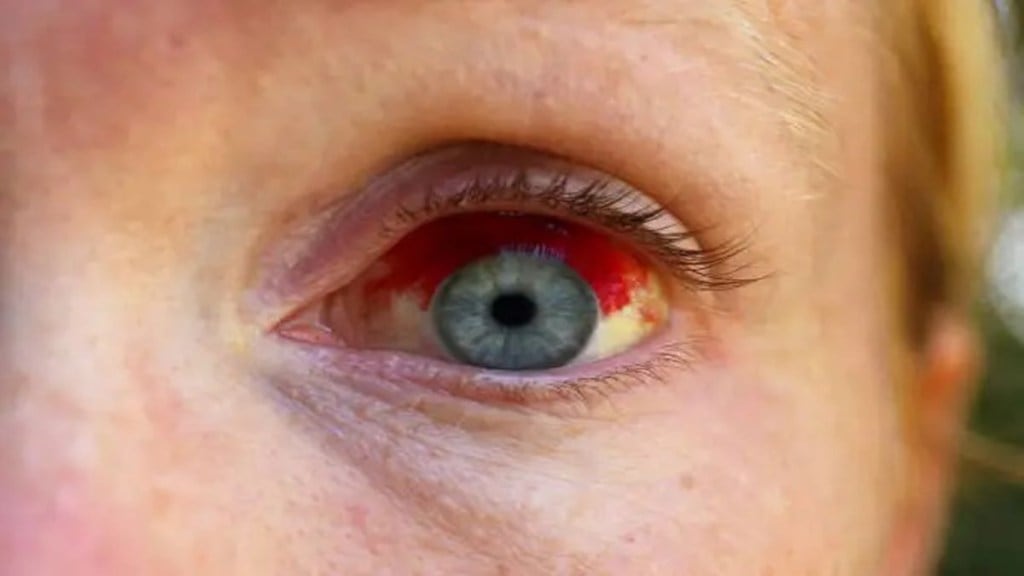In recent months, there has been a surge in conjunctivitis cases, also known as eye flu or pink eye, in India. According to the Center for Disease and Control (CDC), although the symptoms of eye flu vary from person to person, redness or swelling of the white of the eye is the main sign.
In most cases, eye flu will usually clear up in 7 to 14 days without treatment and without any long-term consequences. However, sometimes after the infection, you may experience blood spots in your eyes.
“Blood shot eyes are seen sometimes in viral conjunctivitis where some bleeding occurs under the conjunctiva. It’s called subconjunctival haemorrhage. This may persist after recovery of acute infection as the body takes time to break up and absorb blood components. Hence “blood shot” eyes may persist for some time after eye flu,” Dr Neetu Sharma, Consultant, Ophthalmology, Fortis Hospital, Noida told Financial Express.com.
According to Dr. Shibal Bhartiya, Senior Consultant, Ophthalmology, Fortis memorial research Institute, gurugram, blood-shot eyes can persist even after recovering from eye flu due to several reasons:
Dryness: Even after the eye flu recovers, the eyes may produce fewer tears, leading to dryness and irritation. This is called post-viral dry eyes, and the eyes may therefore have a persistent redness and blood-shot appearance. This is the most common cause of persistent red eyes.
Subconjunctival hemorrhage: Adenovirus, the most common cause of eye flu, can also cause bleeding under the conjunctiva, this is called a subconjunctival hemorrhage. This can take up to four weeks to resolve (depending on amount of bleeding) and may be a reason for the persistent red eyes.
Drug overuse or allergy: Sometimes overuse of eyedrops (especially those containing preservatives) can damage the ocular surface, resulting in low grade persistent inflammation. This also presents as redness and irritation.
Inflammation: Eye flu, or viral conjunctivitis, can cause low-grade persistent inflammation of the tissues in the eyes. Even after the infection has been treated, the blood vessels may still be dilated and remain inflamed, leading to red or blood-shot eyes.
“If bloodshot eyes persist even after recovering from eye flu, it is advisable to consult an eye doctor for a thorough evaluation to determine the cause and appropriate treatment,” Dr. Bhartiya told Financial Express.com.
Dr. Sameer Kaushal, Head, Ophthalmology, Organ Transplant departments, Artemis Hospital, Gurugram maintains that Some types of viral infections of the eye has a tendency to cause subconjuntival haemorrhage.
“It does NOT mean that the patient still has infection or can pass infection to others. Usually by this stage of disease , the patient is not infectious and can therefore continue his or her normal activities,” Dr. Kaushal told Financial Express.com.
What is Subconjunctival hemorrhage?
Conjunctiva which covers the white of your eye contains many tiny blood vessels that can break. This can lead to a condition called subconjunctival hemorrhage. According to doctors, most cases aren’t serious and will go away on their own.
In the case of subconjunctival hemorrhage, the blood is trapped in the conjunctiva and it can’t be moved or wiped away. Although it looks scary, most cases don’t cause any other symptoms or need treatment and disappear on there within a few weeks.
Dr Rashmi Mittal, Consultant, Dept of Ophthalmology, Amrita Hospital, Faridabad told Financial Express.com it is not unusual for the patient to continue having persistent redness of eyes despite resolution of the eye infection.
What are the symptoms of subconjunctival hemorrhage?
According to Cleveland Clinic, other than red spots there are no other symptoms. However, there is a possibility of mild irritation, but there should be no discharge or any other symptoms.
What are the causes of subconjunctival hemorrhage?
According to Mayo Clinic, a subconjunctival hemorrhage often occurs without any obvious harm to your eye. “A break in one or more small blood vessels, just under the transparent to milky outermost covering of the eye, results in the bleeding. This blood in eye (which may be as little as a drop) gets trapped underneath the conjunctiva, much like the blood in a bruise is trapped in the skin,” Dr. Bhartiya told Financial Express.com.
Some of the possible causes are:
- Straining (during coughing, sneezing, vomiting or while using the toilet).
- Injury to your head or eye, including infection.
- Lifting, pushing or bending forward.
- Rubbing your eye too hard.
- Wearing contact lenses.
- Taking medications, including blood thinners and a cancer drug called interferon.
Less common subconjunctival hemorrhage causes include:
- Diabetes.
- High blood pressure.
- Blood clotting disorders.
Subconjunctival hemorrhages sometimes happen without a direct cause
How to treat subconjunctival hemorrhage?
According to Dr. Bhartiya, even though you may find the blood in eye frightening, the condition is not dangerous and does not impact your vision.
“The blood shot eye will change colors just like a bruise in the skin, and may turn brown or green. Your eye will returns to normal within 3 weeks as the blood gets absorbed. Therefore, a subconjunctival hemorrhage does not require any treatment,” Dr. Bhartiya added.
Although it is a harmless condition, subconjunctival hemorrhage can be a sign of a serious underlying disorder, such as:
- Vascular disease.
- A bleeding or blood clotting disorder.
- Severe asthma.
- Non-accidental trauma.
- Severe eye (orbital) trauma.
According to Cleveland Clinic, contact your eye care specialist if you have eye pain along with the red spots.
“The treatment remains simple. Patients can continue lubricating drops. The redness will disappear on its own. In another set of patients the viral infection is gone, but it may remain gently red without being bloodshot. In such cases, the inflammation is taking a little longer to settle and lubricating drops can be used. In general, these are the two common causes for persistent redness after the virus is gone. In both the cases, nothing to panic, simple lubrication and reassurance is all that’s required,” Dr P. Suresh, HOD-Ophthalmology, Fortis Hospital, Mulund told Financial Express.com.








